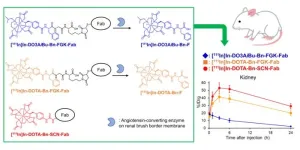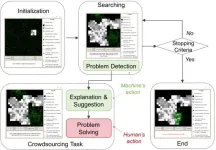(Press-News.org) Thirteen-year-old Grace Hoyt received potentially the best birthday gift ever this month when pediatric ophthalmologists at the University of Colorado School of Medicine and Children’s Hospital Colorado administered the first treatment designed specifically to slow her vision loss associated with posterior column ataxia with retinitis pigmentosa (PCARP), a rare genetic condition that affects vision and the nervous system.
“It’s so incredible that she has this opportunity,” Susan Hoyt says of her daughter, who received the first treatment Aug. 24. “We’ve known that Grace is going to go blind, but to have the chance to stop the inexorable march forward is encouraging.”
The new treatment given with permission from the U.S. Food and Drug Administration as an investigational new drug is the first start-to-finish personalized medication given at Children’s Colorado developed in partnership with the CU Department of Ophthalmology.
“This is my first time applying for Investigational New Drug (IND) approval and the first new drug that I’ve given a patient,” says Emily McCourt, MD, associate professor and the Ponzio Family Chair for Pediatric Ophthalmology, who worked with researchers and physicians in the department, the newly-created CU Anschutz Investigational New Drug and Device (IND/IDE) Office, Boston Children’s Hospital, and non-profit drug developer n-Lorem to create the injectable medication that aims to slow down the patient’s vision loss.
“I learned through the process that sometimes you have to phone a friend, and thankfully we have a lot of expertise on the CU Anschutz campus,” she continues. “The IND office was so helpful, as was the research institute at Children’s Colorado.”
A mystery until diagnosis
McCourt met Grace 10 years ago when she was experiencing some motor delays, trouble seeing at night, and falling without responding in pain. One night, Grace put a sippy cup down and couldn’t find it at all.
“She was about a year-and-a-half old when we realized she couldn’t feel pain,” Susan says. “Then, about a year later, we were sitting her in her room one night and she couldn’t find her cup, but it was right in front of her.”
Soon after, McCourt first saw Grace and noticed that she had retinitis pigmentosa (RP), a blinding condition of the retina that develops over time. It is rare to experience as a young child, McCourt says. Typically people who have the disease are diagnosed in their 20s.
“At that time, we knew it was a clue to an overall diagnosis, but it was still difficult to put it all together,” she says. “Meanwhile, Grace was experiencing infections in the fingers along with broken bones that didn’t seem to hurt at all.”
Genetic testing revealed a few mutations, but none that McCourt says really made any sense. “A lot of the time you need two mutations to have a disease, and this patient only had one mutation in any gene that could explain her symptoms.”
The discovery of a second gene mutation, which researchers describe as a deep intronic mutation, only discoverable through whole genome sequencing, led to the PCARP diagnosis.
“It’s a really difficult disease,” says Marc Mathias, MD, associate professor of ophthalmology and retina specialist at the Sue Anschutz-Rodgers Eye Center, who assisted McCourt through the process of developing the treatment. “It doesn’t just affect the eyes and vision. There’s a systemic component as well, and the disease can develop slowly in childhood so it might not be recognized early on.”
In the last 50 years, PCARP has only been described in about 20 cases.
One patient, one treatment
Because Grace’s disease has a deep intronic mutation, her form of PCARP is amenable to a certain kind of therapy, called antisense oligonucleotide therapy (ASO), that attaches to RNA.
“Basically, you take these little molecules and put them together and make a drug that binds to the patient’s RNA to help the patient’s body make more normal protein and less abnormal protein,” McCourt explains. “We thought perhaps this therapy could work to slow down or stop the progression of the retinal disease.”
Austin Larson, a CU and Children’s Colorado geneticist who had recently given an ASO drug to another patient contacted a lab at Boston Children’s Hospital to see what they thought of the possibility of using an ASO therapy for Grace’s retina. The new partners got to work, using cells grown from Grace’s skin biopsy, which showed promising preliminary results.
From there, developing the treatment required testing, making sure the treatment would be safe for Grace, and finally getting the IND application approved by the FDA.
“Safety was goal number one,” Mathias says. “We wanted to do the right thing for the patient and design a study in a thoughtful way that protects her in the end.”
With the drug designed to treat one patient only, researchers had no control group, making it more challenging to show that the drug will be helpful over time, but studying the effectiveness of the therapy was similar to how scientists research drugs that reach bigger populations, too.
“It builds on a lot of experience we have with other clinical trials, and we went through a similar process,” Mathias says.
n-Lorem, a non-profit foundation dedicated to developing ASO technology to treat nano-rare patients, conducted testing for the trial. Once researchers were satisfied with the therapy, it was off to the FDA to submit an IND application.
“This whole process highlights the fact that medicine is a team sport,” McCourt says.
The power of asking 'what if'
Grace is expected to need the medication, through injections into the eyes, for the rest of her life.
“Because she doesn't feel pain, it's extremely important that Grace hangs on to whatever vision she has left so she can see her body, and evaluate herself for injuries” Susan says. “I am so grateful to Dr. McCourt for asking ‘what if’ and making the impossible happen for my girl.”
CU ophthalmologists will monitor her progress and watch for vision loss. McCourt and Mathias expect an injection may be necessary every three to six months. The treatment is being manufactured by n-Lorem for the rest of Grace’s life at no cost.
“It’s really taken a village to accomplish this,” echoes Mathias. “There has been support from many players including Grace, who has shown us all the reasons her family calls her Amazing Gracie.”
END
University of Colorado ophthalmologists administer novel treatment for single patient facing rare genetic condition
Fewer than 20 patients have been diagnosed with posterior column ataxia with retinitis pigmentosa (PCARP) in the last 50 years. When Grace Hoyt became one of them, Department of Ophthalmology faculty members sought out a treatment solution.
2023-09-06
ELSE PRESS RELEASES FROM THIS DATE:
Novel molecular design for enhanced efficacy and safety in radiotheranostics
2023-09-06
Radiotheranostics embodies the convergence of diagnostic and therapeutic radiopharmaceuticals into a unified platform. In cancer treatment, radiotheranostic procedures typically involve the use of antibodies that bind to proteins abundantly found on the surface of cancerous cells. The antibodies are labeled with a suitable radioisotope, which facilitates imaging procedures used to diagnose cancer and can be used to target cancerous cells and bombard them with deadly radiation as a form of treatment.
Although radiolabeled antibodies show promise as a treatment for cancer, several hurdles impede their clinical translation. ...
Potential target for reversing drug resistance in ovarian cancer identified
2023-09-06
For the 314,000 people diagnosed with ovarian cancer each year, hope often comes in the form of platinum-based drugs such as cisplatin.
Cisplatin causes the death of quick-dividing tumour cells, so it is a potent first-line defence in the treatment of the often fatal disease.
However, over half of ovarian cancer patients develop recurrence and become resistant to cisplatin and other platinum-based chemotherapies, contributing to the five-year survival rate of 31%.
It is unclear why this resistance occurs, but a solution is urgently ...
Human-AI collaboration improves source search outcomes
2023-09-06
When artificial intelligence robots that have been designed to use algorithms to complete source search tasks, such as search and rescue operations during a fire, encounter a disturbance, they are often unable to complete their task. Proposed solutions have ranged from trying to improve algorithms to introducing additional robots, but these AI-driven robots still encounter fatal problems.
Researchers have proposed a solution: a human-AI collaboration that takes advantages of the unique skills of the human brain to overcome challenges.
The paper was published in the Journal of Social ...
Teleneurology challenges met by training curriculum
2023-09-06
A new physician-training system in telehealth simulates key parts of traditional, in-person neurological exams that use little reflex hammers, pinpricks, and flashlights to test nerve function. The three-year program, which was designed by researchers at NYU Grossman School of Medicine, has trained at least 68 neurology residents since its rollout in 2020. Published online Aug. 3 in Neurology Education, a new analysis of the curriculum identifies challenges to translating in-person exam techniques ...
A secret for boosting hotel bookings: analyze online user reviews for your hotel and your competitors
2023-09-06
Researchers from Texas Christian University, University of South Carolina, and RealPage published a new Journal of Marketing article that examines the impact of online reviews on hotel booking performance with a specific focus on the competitive effects of reviews.
The study, forthcoming in the Journal of Marketing, is titled “The Competitive Effects of Online Reviews on Hotel Demand” and is authored by Sanghoon Cho, Pelin Pekgun, Ramkumar Janakiraman, and Jian Wang.
Recent reports indicate that a majority of consumers trust online reviews as much as personal recommendations when deciding to book a hotel. A 2019 study ...
Rubber plumbing seals can leak additives into drinking water, study says
2023-09-06
As drinking water flows through pipes and into a glass, it runs against the rubber seals inside some plumbing devices. These parts contain additives that contribute to their flexibility and durability, but these potentially harmful compounds can leak into drinking water, according to a small-scale study in ACS’ Environmental Science & Technology Letters. The authors report that the released compounds, which are typically linked to tire pollution, also transformed into other unwanted byproducts.
To enhance rubber’s strength and durability, manufacturers typically mix in additives. Scientists have shown that tire dust ...
Mount Sinai announces partnership with the Brazilian Clinical Research Institute to advance cardiovascular disease research and medical education
2023-09-06
The Icahn School of Medicine at Mount Sinai announced today that it has signed a memorandum of understanding with the Brazilian Clinical Research Institute (BCRI) to focus on advancing cardiovascular disease research, innovation, and medical education.
"This partnership is part of a broader initiative to expand Mount Sinai Heart’s reach globally, and Latin America is an important part of that goal," said Deepak L. Bhatt, MD, MPH, Director of Mount Sinai Heart and Dr. Valentin Fuster Professor of Cardiovascular Medicine at Icahn Mount Sinai. "Our partnership ...
Recent advances in melon and gourd research
2023-09-06
As summer draws to a close, the long vines and tendrils of most melons and gourds in the Cucurbitaceae family snake their way along the ground. And they’re dotted with fruits, such as cucumbers or pumpkins. Below are some recent papers published in ACS journals that report insights into melons’ potential health impacts, pathogens and contaminants. Reporters can request free access to these papers by emailing newsroom@acs.org.
“Nanoparticles Loaded with a Carotenoid-Rich Extract from Cantaloupe Melon Improved Hepatic Retinol Levels in a Diet-Induced Obesity Preclinical Model”
ACS ...
Broad Institute of MIT and Harvard announces a new research alliance with Novo Nordisk to identify therapeutic targets for type 2 diabetes and cardiometabolic diseases
2023-09-06
Cambridge, MA (September 6, 2023) — The Broad Institute of MIT and Harvard today announced a new research alliance with Novo Nordisk aimed at addressing critical unmet clinical needs in diabetes and cardiometabolic diseases. The collaboration will focus on advancing three programs over the next three years. Two programs aim to identify drug targets for clinically important subtypes of type 2 diabetes, which affects more than 37 million people in the United States alone, and one program aims to unravel the genetic roots of cardiac fibrosis, or scarring of the heart, which occurs in many cardiovascular diseases that can lead to ...
MD Anderson and Panacea launch Manaolana Oncology to develop antibody-based therapies for cancer
2023-09-06
HOUSTON and SAN MATEO, Calif. ― The University of Texas MD Anderson Cancer Center and Panacea Venture today announced the launch of Manaolana Oncology Inc., a new company created to develop and advance antibody-based therapies against novel cancer antigens.
Manaolana Oncology seeks to build upon the innovative antibody production capabilities and intellectual property of MD Anderson to research and develop novel monoclonal antibodies (mAbs) and other antibody-based therapies for a variety of cancer types, with the goal of advancing promising therapies into ...
LAST 30 PRESS RELEASES:
Research validates laboratory model for studying high-grade serous ovarian cancer
SIR 2026 delivers transformative breakthroughs in minimally invasive medicine to improve patient care
Stem Cell Reports most downloaded papers of 2025 highlight the breadth and impact of stem cell research
Oxford-led study estimates NHS spends around 3% of its primary and secondary care budget on the health impacts of heat and cold in England
A researcher’s long quest leads to a smart composite breakthrough
Urban wild bees act as “microbial sensors” of city health.
New study finds where you live affects recovery after a hip fracture
Forecasting the impact of fully automated vehicle adoption on US road traffic injuries
Alcohol-related hospitalizations from 2016 to 2022
Semaglutide and hospitalizations in patients with obesity and established cardiovascular disease
Researchers ‘listen in’ to embryo-mother interactions during implantation using a culture system replicating the womb lining
How changing your diet could help save the world
How to make AI truly scalable and reliable for real-time traffic assignment?
Beyond fragmented markets: A new framework for efficient and stable ride-pooling
Can shape priors make road perception more reliable for autonomous driving?
AI tracks nearly 100 years of aging research, revealing key trends and gaps
Innovative techniques enable Italy’s first imaging of individual trapped atoms
KIER successfully develops Korea-made “calibration thermoelectric module” for measuring thermoelectric device performance
Diversifying US Midwest farming for stability and resilience
Emphasizing immigrants’ deservingness shifts attitudes
Japanese eels, climate change, and river temperature
Pusan National University researchers discover faster, smarter heat treatment for lightweight magnesium metals
China’s 2024 Gastroenterology Report: marked progress in endoscopy quality and disease management
Pusan National University researchers uncover scalable method for ultrahigh-resolution quantum dot displays
Researchers use robotics to find potential new antibiotic among hundreds of metal complexes
Gut bacteria changes at the earliest stages of inflammatory bowel disease
Scientists develop new way to “listen in” on the brain’s hidden language
Brain research: “Pulse generators” grow and shrink as memories are formed
For teens, any cannabis use may have impact on emotional health, academic performance
School meals could unlock major gains for human and planetary health
[Press-News.org] University of Colorado ophthalmologists administer novel treatment for single patient facing rare genetic conditionFewer than 20 patients have been diagnosed with posterior column ataxia with retinitis pigmentosa (PCARP) in the last 50 years. When Grace Hoyt became one of them, Department of Ophthalmology faculty members sought out a treatment solution.



